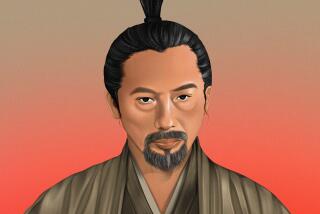Hideko Takamine dies at 86; one of Japan’s leading screen actresses
Hideko Takamine, a child star in Japan in the 1930s who became one of her country’s leading screen actresses during the post- World War II era, in which she played a variety of contemporary women who captured the tenor of the times, has died. She was 86.
FOR THE RECORD:
Hideko Takamine: In the Jan. 5 LATExtra section, the caption for a photo that appeared with the obituary of Japanese actress Hideko Takamine misspelled the name of the actor with whom she was pictured. He was Eijiro, not Fijiro, Tono.
Takamine, who died of lung cancer Dec. 28 in Tokyo, made her screen debut at age 5 in the hit 1929 silent film “Mother” and is said to have been in more than 300 films in a career that ended when she retired in 1979.
“Hideko Takamine was one of the most beloved and accomplished of Japan’s film stars,” said Kevin Thomas, a former Times staff writer who reviewed Japanese films from 1962 to 1985. “She was beautiful, and she had tremendous range and versatility.”
After beginning as “sort of Japan’s answer to Shirley Temple,” Thomas said, “she emerged as one of Japan’s greatest star actresses in the postwar period, which was a tremendous period for Japanese cinema.”
In the wake of the war, Thomas said, “there was this renaissance of Japanese filmmaking. They could discuss the war and assess blame, the impact of the occupation, the growing emancipation of women — all this kind of stuff. There was this terrific ferment, and it was a really creative period.”
And for many Japanese, Phyllis Birnbaum wrote in her 1990 New Yorker profile of Takamine, “she was as much a part of postwar Japan as the strange-tasting powdered milk distributed by the American military.”
“Many of Takamine’s heroines were typical of the women who had grown up after the war,” film historian Donald Richie told Birnbaum. “Like so many Japanese women then, they wanted more out of life, but couldn’t get it.
“The war may have been over, women found, but they weren’t better off. They were still fairly unhappy. So the kind of roles Takamine played fit the zeitgeist, may have even made that zeitgeist.”
Takamine, who left the studio system to freelance in 1950, made many of her most notable films with directors Mikio Naruse and Keisuke Kinoshita.
They included playing a stripper in Kinoshita’s satirical 1951 film “Carmen Comes Home,” Japan’s first feature film in color; and a schoolteacher in Kinoshita’s 1954 antiwar film “Twenty-four Eyes.”
She also memorably played what film critic Michael Wilmington once described as “a woman obsessively in love with an unworthy man” in Naruse’s acclaimed 1955 film “Floating Clouds” and was a widowed bar hostess in Naruse’s “When a Woman Ascends the Stairs” (1960).
“Both directors have the reputation for the depiction of women, though their styles are completely different,” Takamine told the Straits Times in 1994. “During more than 10 years, I passed from one to another, just like a ping-pong ball.
“Though different in style, they shared a common aversion to things that were not natural. What I tried to do was to be as natural as women we see in the news, but adding a touch of drama so that I would be even more real.”
In 1955, the year Takamine became Japan’s No. 1 female box-office star, she married writer-director Zenzo Matsuyama, who survives her and with whom she made a number of films.
When they married, Takamine told the media she wanted to “create a new style of wife who has a job.”
Takamine was born March 27, 1924, in Hakodate on the island of Hokkaido.
When she was 4, her mother died and her father placed her in the care of his sister in Tokyo. A year later, with her aunt serving as stage mother, Takamine was in the movies. She appeared in an estimated 100 films as a child, including sometimes portraying little boys.
“There were no child-labor laws, and I was supporting my family,” she said of her days as a child star in a 1983 interview with the New York Times.
Unlike many child stars, Takamine made a successful transition into her teen years.
During World War II, she toured Japanese army camps as a singer. And immediately after the war, she sang for American occupation troops at a theater in Tokyo.
“I was singing American songs like ‘You Are My Sunshine,’ ” she said in the 1983 interview. “I didn’t have time to think about whether I liked it or didn’t like it. It was work. And backstage, I was getting flowers and chocolates and K-rations, so thanks to Americans I survived.”
Takamine retired after making the Kinoshita-directed “Oh My Son!” in 1979.
Asked in the 1983 interview if she had any regrets about her career, the outspoken Takamine said: “Every day I hated it. For 50 years, I hated it, but a sense of professional pride drove me on.”
Takamine, whose education was neglected as child and who said she had to learn to read by herself, wrote a number of books, including “My Professional Diary,” a 1976 two-volume autobiography.
More to Read
Start your day right
Sign up for Essential California for the L.A. Times biggest news, features and recommendations in your inbox six days a week.
You may occasionally receive promotional content from the Los Angeles Times.






